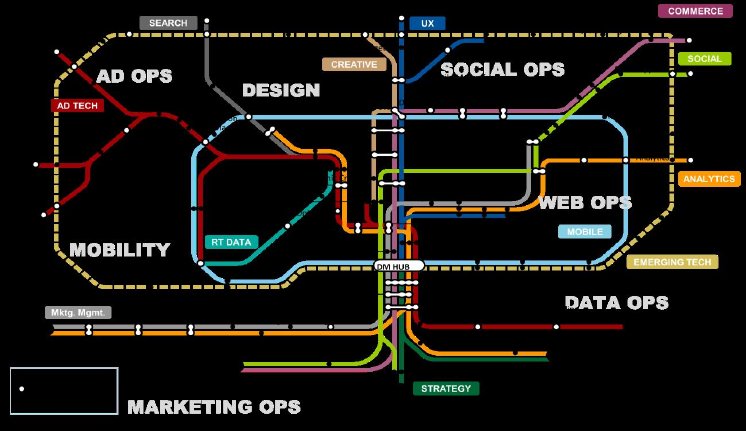"Digital marketing organisations have accumulated most of their technologies in discrete initiatives, often one technology at a time," said Yvonne Genovese, managing vice president at Gartner. "This approach creates silos that don't work together and leads digital marketers to overlook strategies and technologies that improve efficiency and effectiveness of marketing efforts."
"Gartner's digital marketing transit map presents a comprehensive landscape of marketing technologies that will enable organisations to see every kind of service and technology that is available and how they relate to each other," said Andrew Frank, vice president and distinguished analyst at Gartner. "This will allow them to identify the best sources for their needs and acquire systems that work well together."
A transit map is a proven tool for communicating complex information in an intuitive way. In this way, the map provides a metaphor for digital marketing. Neighbourhoods (see Figure 1) represent functional regions that can be thought of as centres of excellence within an organisation. Tracks connect these regions and can be thought of as application services that share common objectives and information. Stations represent interaction points that can be thought of as vendor and production categories that provide platform and point solutions. Intersections represent transfer points where solutions may serve more than one business area.
Neighbourhoods: The labels in light gray indicate operational areas. The neighborhoods are necessarily broad in outline, but they give a general sense of where to look for solutions. For example, if someone manages ad operations, they don't have to limit themselves to ad tech when they look for technology support. Emerging tech, mobile and analytics can also play a role. When beginning a project, take an inventory of the capabilities that already exist in that area. Organisations should review the transit map to find all possible technologies that could help, as well as overlaps where two functions can be fulfilled with one technology or perhaps where an existing technology can be adopted for another function.
Tracks: The coloured lines represent broad application domains. All the lines intersect at a main station, labelled "digital marketing hub." Two lines, emerging technology (yellow) and mobile (light blue), are circular to indicate that they touch all other categories. The dotted line for emerging technologies indicates that this category is "unfinished," with technologies maturing and moving onto other lines and new technologies appearing continually.
Stations: Each line has a number of stations that represent technology types. The smaller circles are types of product (for example, gamification tools) where multiple providers to evaluate can be found. The larger shapes represent types of technology providers (for example, mobile marketing) that may offer different kinds of services and technology to fulfil related functions. The black circles near the bottom of the map represent connections to technologies and functions outside of marketing (such as business intelligence). The circles (sometimes joined by black lines) that appear where two or more lines intersect indicate products and vendors that span the adjacent categories. For instance, mobile search spans both the purple search line and the light blue mobile line. With these "transfer stations," two or more functions can be performed with one technology.
The overall layout of the transit map is structured as follows:
- To the south are the "business districts" that connect with other parts of the organisation: IT, sales and service, general marketing, business intelligence and general advertising, which is often outsourced to agencies.
- The stop in the centre, labelled "digital marketing hub," is the central station where all of the functions converge.
- In the northwest are services aimed at awareness and traffic: advertising and search.
- In the northeast are services concerned with engagement quality: creative and user experience.
- Due north are services concerned with engagement quality: creative and user experience.
- Mobile and emerging technology loops indicate that they touch all other categories. The broken line representing emerging technology indicates areas under construction.
"We created the landscape for digital marketing in the form of a transit map to show complex relationships among a large number of technologies and operational areas," said Jake Sorofman, research director at Gartner. "Organisations should use the map to identify the connection among business functions, applications tracks and providers. Map elements can be used to find additional research or structure questions about strategy and best practices as well as providers, products and selection criteria. It is also a useful device for mediating discussions between marketing and IT."
More detailed analysis is available in the report "Toolkit: The Digital Marketing Transit Map." The report is available on Gartner's website at http://www.gartner.com/.... Additional information and resources on the digital marketing transit map can be found at http://gtnr.it/14I0qh7.
Mr Frank will provide additional details on the transit map in the complimentary webinar, "Making Sense of the Digital Marketing Landscape," today (20 June), at 2pm BST and 5pm BST. He will explain how clients can use Gartner's interactive transit map to understand connections, evaluate solutions, and put your organisation on a rational course. To register for the webinar, please visit http://gtnr.it/14FU9me.
This research is part of the Gartner for Marketing Leaders program. This program provides real-time, personalised digital marketing guidance, from vision through execution. Gartner for Marketing Leaders is focused on helping digital marketers succeed in eight key areas: emerging digital marketing trends and techniques, social marketing, mobile marketing, monetising digital marketing through commerce, multichannel marketing, data-driven marketing, digital marketing essentials and digital marketing programs. Additional information is available at http://www.gartner.com/.... For additional details, email GML@gartner.com.



